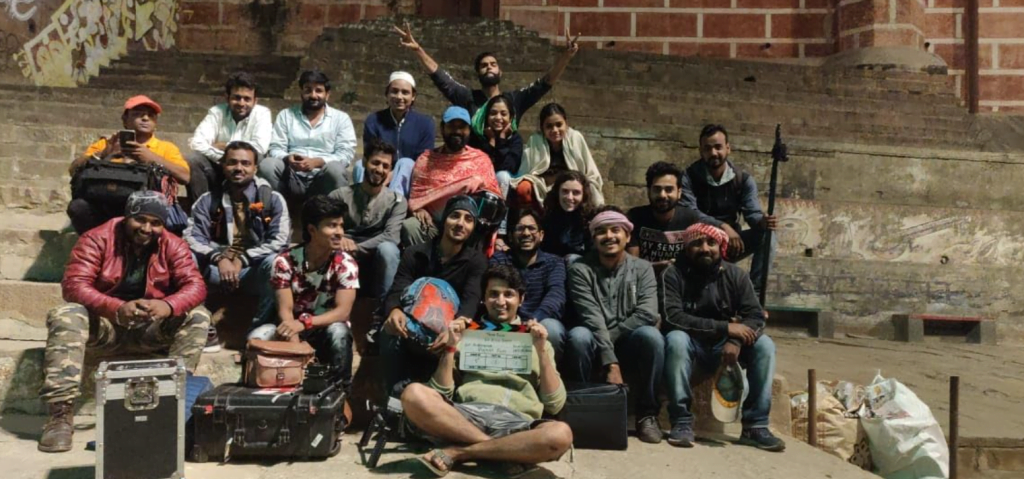Film Director Ritesh Sharma was formerly a theatre performer. Having been involved in theatre since his childhood, he eventually became interested in filmmaking while pursuing his degree at Delhi University. Recently, his 2021 debut film won The Best Debut Feature Film at the New York Indian Film Festival.
In an interview with FII, Ritesh Sharma discusses his debut film ‘Jhini Bini Chadariya‘ and the institutional impediments in India’s Entertainment Industry.
FII: Can you tell us a bit about your background and what inspired you to become a Filmmaker?
Ritesh: I am from Bihar, Gaya and grew up in Mughalsarai. I started as a Theater performer from Mancha (also known as Natak). For most of my life, I’ve seen mainstream Bollywood films, but my interest in filmmaking grew with my graduation from Delhi University. I have been participating in theater since childhood and I have always wanted to be an actor but I guess life had better plans when I was pursuing my degree. I watched some phenomenal directors like Shyam Benegal, and Satyajit Ray and watched some exceptional Iranian films, that’s what drew my interest in filmmaking.
FII: What specific experiences or influences led you to make Jhini Bini Chadariya?
Ritesh: I came across a dancer in UP and I got my idea from there, and that’s where I envisioned my first character Rani. I noticed hundreds of men were looking at her with passion in their eyes while she performed on stage. It amazed me to see how people can torment a girl while she is simply doing her job. She was the center of attention with everyone looking at her as if they were going to eat her. After this I started to study their life.

I started looking around for my story and that’s when I found my second lead Shadab, who is a weaver. And akin to that I started to add more characters to my story Adah, Baba and others. To be precise, I began work on the story in 2015 and completed my research in 2016. I spent 6 months forming my ideas surrounding weavers and by the end of 2017, I was nearly finished with the writing.
When I got to the real stuff in 2018, we started shooting. We kept filming and editing, but then COVID hit out of the blue, and we weren’t affected. We filmed the ending scenes, and by 2021, we were done with the whole thing.
FII: Your Film tackles significant socio-political issues, so what motivated you to address these particular themes?
Ritesh: Well, you’ll see from looking at my career that the themes of my short films have always centred around socio-political conditions and I think we must comprehend the value of a film and the potential effect it may have on our life. My short film “Laal Mati” focuses on the life of indigenous tribal groups in Jharkhand, addressing the exploitation and suffering these communities face as a result of mining activity.

In a nutshell, Jhini Bini Chadariya was not my first work that dealt with this topic. As I previously mentioned I grew up watching mainstream Bollywood films but because I was already a theatre artist, the kind of film I saw during my degree at Delhi University, gave me a fresh perspective and fundamentally altered my idea of cinema.
FII: The title “Jhini Bini Chadariya” is quite evocative. Can you explain its significance and how it relates to film context?
Ritesh: Initially it was not “Jhini Bini Chadariya,” it was named “Tana Bana.” Later I got the title “Jhini Bini Chadariya” which is indeed evocative and rich with culture and metaphorical significance. The phrase is derived from Kabir, who wrote “Jhini Bini Chadariya” translates to “The finely woven cloth” which metaphorically represents the human body and soul. Kabir uses this imagery to convey the fragility and transient nature of life, emphasising the spiritual purity of all beings both symbolically and physically.
I shot this film in Varanasi, which is also the land of Kabir, and the story centres on the family of weavers. I believe the way it ends highlights the characters’ chastity as well as their pain and losses, which is relevant to the theme.
FII: What systemic barriers to inclusion do you see in the Indian Entertainment Industry?
Ritesh: Though I still think films can impact and attract audiences, in recent years attendance at the cinema has taken precedence above the actual substance. For me, films are about more than just earning money at the box office, these days most films are about making more money. The Production Companies operate in the same way; consequently, we don’t receive any truly relevant content because our audience is drawn to films with big budgets.
Films like “Animal” demonstrate how we employ film as a means of tool to set a narrative in the minds of viewers, and they also signify the mentality of those who work in the industry. These kinds of films have the potential to negatively impact our youth.
Ritesh Sharma
Films like “Animal” demonstrate how we employ film as a means of tool to set a narrative in the minds of viewers, and they also signify the mentality of those who work in the industry. These kinds of films have the potential to negatively impact our youth. Briefly, I believe the people of cinema have lost their purpose, while some continue to strive, attempt and create magic with their crafts.
FII: What Impact do you hope the film will have on the community it portrays and in what ways do you think a film like “Jhini Bini Chadariya” can drive social change?
Ritesh: The reason it was not initially distributed in India was that I was aware that the censor board would undoubtedly request modifications for which I was not yet prepared. Even though this film was screened at numerous film festivals worldwide, including in India, and received the award for best debut feature film at the New York Indian Film Festival, as well as having a world premiere at the Tokyo Film Festival, the first Indian screening occurred at the IFFK (International Film Festival of Kerala). I was taken aback by the audience’s reaction.

I remember, there was one boy who came and hugged me after the screening, which is insane but to be honest, people have responded well to the film wherever it has been screened. When an audience relates to a work of art, such reactions are inevitable. I believe that we should pay more attention to the message of the film, which is to help people understand the problems of social class and stratum. Although the film is not a work of documentary, it does deal with issues that are relevant to everyday life.
About the author(s)
Sumaiya Sayeed is an adaptable independent writer and translator (subtitler) who has a love for creating engaging content for a range of markets. Sumaiya is a freelance writer with a background in Communicative English. She specialises in producing captivating blog posts, articles, and content that draws readers in. she is capable of producing excellent work on schedule. When she's not pounding away at a keyboard, she likes to try out new hobbies to keep her skills sharp. Her hobbies include attending film festivals and film screening, writing screenplays, reading and street photography.





